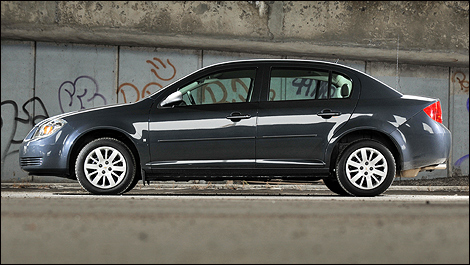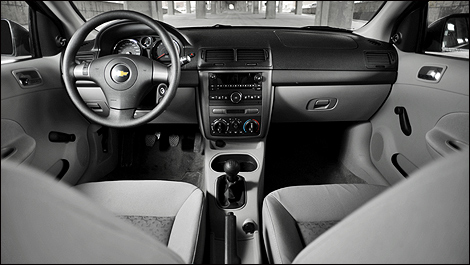If you combine sales of the Chevrolet Cobalt and Pontiac G5 together, only the Honda Civic outsold them in Canada during the 2008 calendar year. Yet the automotive press keeps ranking the Cobalt at the bottom of the compact-car crowd. Could it be that auto writers are completely devoid of common sense, or does this Chevy fulfill compact sedan buyers' needs? It might be a little of both.
 |
| The Cobalt is a sympathetic car that offers a comfortable ride, decent interior space and good fuel economy. |
Actually, one thing that helps a lot is GM's ad campaigns that emphasize the Cobalt's low finance rates. As this is being written, this Chevy can be financed at 0% for up to 72 months. Pay cash, and you get a rebate between $3,100 and $4,000 depending on the model. GM is also offering free maintenance for 3 years and free
OnStar and
XM radio for 2 years.
Low fuel consumptionThe 2.2-litre engine in the Cobalt develops 155 horses and 150 lb-ft of torque. That's more ponies than the base engines in every compact sedan except the 170-hp Subaru Impreza and VW Jetta, which costs thousands more. Overall, it's an unexciting unit that gets the job done without fuss.
Unexciting here means that you don't really feel all that power underneath your right foot. Still, zero to 100 km/h takes 9.0 seconds, which isn't bad. The car's steering is pretty communicative, though, and the comfortable ride is one of the Cobalt's strongest points.
For XFE duty, the transmission gets a lower final drive ratio, which means slightly slower acceleration but lower revs at equal speed, and low-rolling resistance tires. GM claims 13-percent better consumption around town and 8 percent better on the highway. However, the winter tires on our test car eliminate part of the expected improvement.
Our result is an average of 7.4 L/100 km, which we think is pretty good for an engine of this size. The XFE mods seem to pay off around town, where the engine is happy to chug along at just 1,200 rpm. At 100 km/h, the tach is showing 2,200 rpm, and non-XFE Cobalt owners in Auto123.com's forum report the same numbers.
 |
| The 2.2-litre engine in the Cobalt develops 155 horses and 150 lb-ft of torque. |
Goes by unnoticedThere are so many Cobalts and G5s on the road that they have become part of the landscape, so if you're looking for a car that draws attention, shop for something else. The same can be said for the other big guns in the compact category, namely the Honda Civic and the
Toyota Corolla, but the Cobalt's styling is much more conservative.
 |
| If you're looking for a car that draws attention, shop for something else. |
Still, the car looks reasonably modern, but the lack a mid-cycle facelift means it looks just like the 2005 model, so buying a 2009 might not give you the impression that you're in a brand-new car if you've created a habit of changing every four or five years.
Pension-fund cockpitInside the Cobalt is where you'll mainly realize how high the proportion of the car's retail price is reserved for the retired workforce. Cost-cutting measures are found everywhere, such as the industrial quality of the seat fabric and the coarse feel of the dashboard and door plastics.
There is nothing wrong with the car's ergonomics, and the instrument panel's layout is simple and straightforward. A fuel economy average display is standard, which is a nice feature for a basic car. The CD player doesn't read MP3 files, though; an extra $290 for a sound system upgrade solves this, but it should be standard-issue.
The front seats are acceptable for short trips, but after a while, our lower backs start getting sore. Back-seat space and comfort is good for two adults, but three can be a squeeze. Trunk space is among the most spacious among compact sedans.
CompetitionThe Cobalt XFE starts out at $15,325, and our test car is equipped with A/C ($1,150), side-curtain airbags ($395), OnStar ($395) and ABS brakes ($600), for an affordable total of $17,865. We suggest adding the dealer-installed front armrest, which costs $195. But we're wonder why in the base Cobalt, you can't get air conditioning with the automatic transmission.
 |
| Inside the Cobalt is where you'll mainly realize the cost-cutting measures. |
There are numerous competitors in the compact-car segment, and this Chevy doesn't have an easy task:
Dodge Caliber SE, $16,395
Ford Focus S sedan, $15,699
Honda Civic DX sedan, $16,990
Hyundai Elantra L, $15,845
Kia Spectra LX, $15,695
Mazda3 GX (2010), $15,995
Mitsubishi Lancer DE, $16,598
Nissan Sentra 2.0, $14,998
Pontiac G5 XFE sedan, $15,745
Saturn Astra XE 5-door, $18,390
Subaru Impreza 2.5i 4-door, $20,995
Suzuki SX4 sedan, $17,395
Toyota Corolla CE (2010), $15,610
Volkswagen City Jetta, $16,900
 |
| The fuel-savings gain isn't that substantial, especially once you bolt winter tires on. |
Some models may seem expensive by comparison, such as the Astra and Impreza, but they include standard equipment that is optional in others. The Kia Spectra is about to be replaced by the 2010 Forte.
ConclusionThe Cobalt is a sympathetic car that offers a comfortable ride, decent interior space and good fuel economy. As for the XFE mods, the fuel-savings gain isn't that substantial, especially once you bolt winter tires on, so if you're more inclined towards a better-equipped LT, don't restrain.
Yet compared to quite a few rivals, the fit and finish of the Cobalt is underwhelming. It doesn't feel as refined or as its Civic, Mazda3 and Corolla arch-rivals. It doesn't feel as expensive as it costs. But this criticizm doesn't do the car justice; it does the job it's asked to do without complaint and is backed by a good powertrain warranty. That's why 60,000 Cobalt and G5 buyers chose them, and we can't argue with that.





